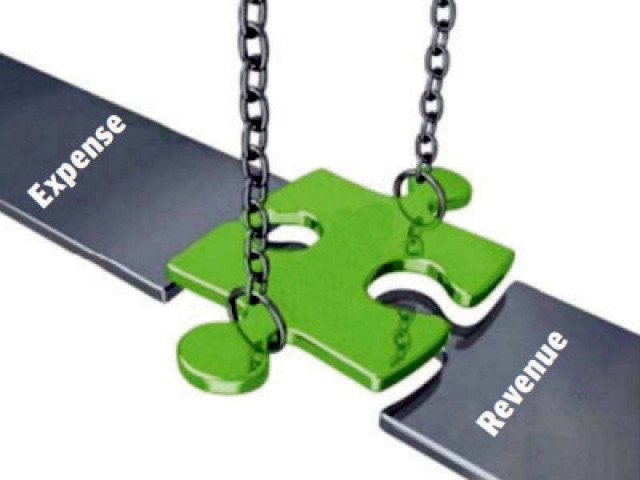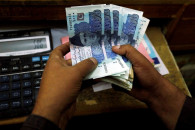Federal deficit widens to Rs1tr
64% of total expenses went into interest payments on loans and defence

The federal budget deficit widened by 43%, to over Rs1 trillion in the first quarter of the current fiscal year, as the rise in expenditure more than doubled the pace of gross revenues due to uncontrolled spending on debt servicing.
Once again, the fiscal operations summary released by the Ministry of Finance on Friday disclosed poor budgetary management. “Statistical discrepancy” of over Rs101 billion surfaced in the federal government’s accounts again, becoming the second major discrepancy to emerge in the last four months.
The federal budget deficit, the gap between expenses and revenues, was equal to 1.3% of the GDP or Rs1.026 trillion during July-September, according to the finance ministry. The details showed that this gap was Rs311 billion or 43% more than the comparative period of the last fiscal year.
The federal government booked a primary deficit of Rs73 billion or 0.1% of the GDP. The initial trend indicates that, even if Pakistan had not been struck by devastating floods, it was impossible to achieve the primary budget surplus target of Rs153 billion, which the government agreed with the International Monetary Fund (IMF).
During the current fiscal year, the federal government’s total expenditure shot up to Rs1.991 trillion, 28% or Rs436 billion higher than the comparative period last year. The current expenditure of the federal government rose to nearly Rs1.85 trillion. There is an increase of 36% or Rs492 billion in the current expenses compared to the same period a year ago.
According to the finance ministry, during the July-September period of the current fiscal year, 64% of the total expenses were on account of just two heads; interest payments on loans and defence. This left very few funds behind to spend on the welfare and development of the country.
A major chunk, of Rs954 billion, was spent on debt servicing the previously obtained loans. The spending on debt was Rs332 billion or 54% higher than the previous fiscal year. The trend is alarming as it suggests that after servicing its debt or paying the salaries due to the armed forces and civilian employees, Pakistan has no money left.
A sum of Rs835 billion was also spent on domestic debt servicing, up by Rs264 billion or 46% on the back of higher interest rates. Foreign debt servicing increased to Rs119 billion, higher by Rs67 billion or 129%, mainly because of currency devaluation and higher servicing.
Rs313 billion was spent on defence, Rs52 billion or 20% more than the previous fiscal year.
The cumulative spending on debt servicing and defence remained at Rs1.27 trillion, which is equivalent to 68% of the country’s current expenses.
Compared to this, only Rs74.5 billion was spent on development, which is Rs69 billion or 48% less than in the previous fiscal year.
In the last fiscal year, the federal budget deficit had skyrocketed to over Rs5.6 trillion, a 51% increase over the preceding year. The gap of Rs5.61 trillion between the federal income and expenditure was the highest-ever in the history of the country.
Under the IMF programme, Pakistan has committed to converting the primary deficit, calculated after excluding interest payments into a surplus of 0.2% of GDP, down from last fiscal year’s 3.6%.
However, the World Bank in its Post Disaster Need Assessment report of the flood stated that due to the floods, the country may run an overall primary deficit of 3% of the GDP again in the current fiscal year.
Gross revenues of the federal government increased to Rs1.84 trillion, higher by Rs197 billion or 12%, however, the pace of increase in revenues was far lower than the 28% growth in expenses.
Net federal revenues, of Rs964 billion after paying provinces’ shares, were not even sufficient to fund the debt and defence expenditures. The federal government transferred Rs880 billion to provinces as their share in federal taxes, which was 9% higher than last year.
During the first three months, the Federal Board of Revenue’s (FBR) tax collection remained at Rs1.634 trillion, up by Rs236 billion or 17%.
The non-tax revenues amounted to Rs211 billion, down by Rs39 billion or 17% due to zero profits shown by the State Bank of Pakistan (SBP). In the first quarter of the last fiscal year, the central bank had given profit of Rs109 billion.
The previous government, however, had given absolute autonomy to the SBP on the whims of the IMF by amending its law, the SBP Act of 1956 in January 2022. Under the law, the central bank will now give its entire profit during the last quarter of the fiscal year.
The collection on account of petroleum levy amounted to hardly Rs48 billion, but still higher by 257%. The federal government needs to collect Rs855 billion on account of the petroleum levy during the current fiscal year.
After incorporating the cash surplus of over Rs218 billion achieved by the provincial governments, the overall deficit of the country stood at Rs808 billion or 1% of the GDP. The overall primary balance was Rs145billion or close to 0.2% of the GDP.
Published in The Express Tribune, November 5th, 2022.
Like Business on Facebook, follow @TribuneBiz on Twitter to stay informed and join in the conversation.



















COMMENTS
Comments are moderated and generally will be posted if they are on-topic and not abusive.
For more information, please see our Comments FAQ